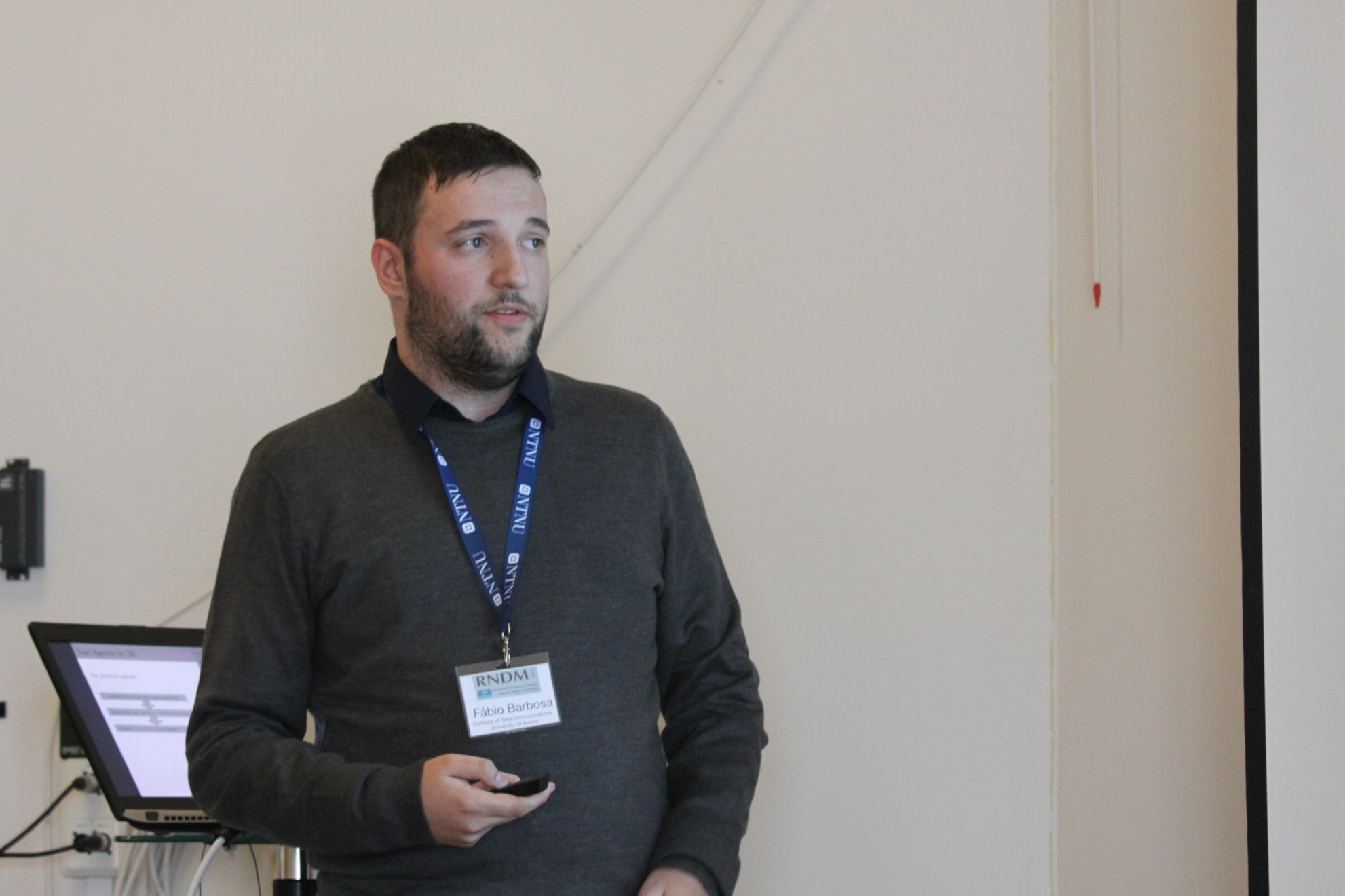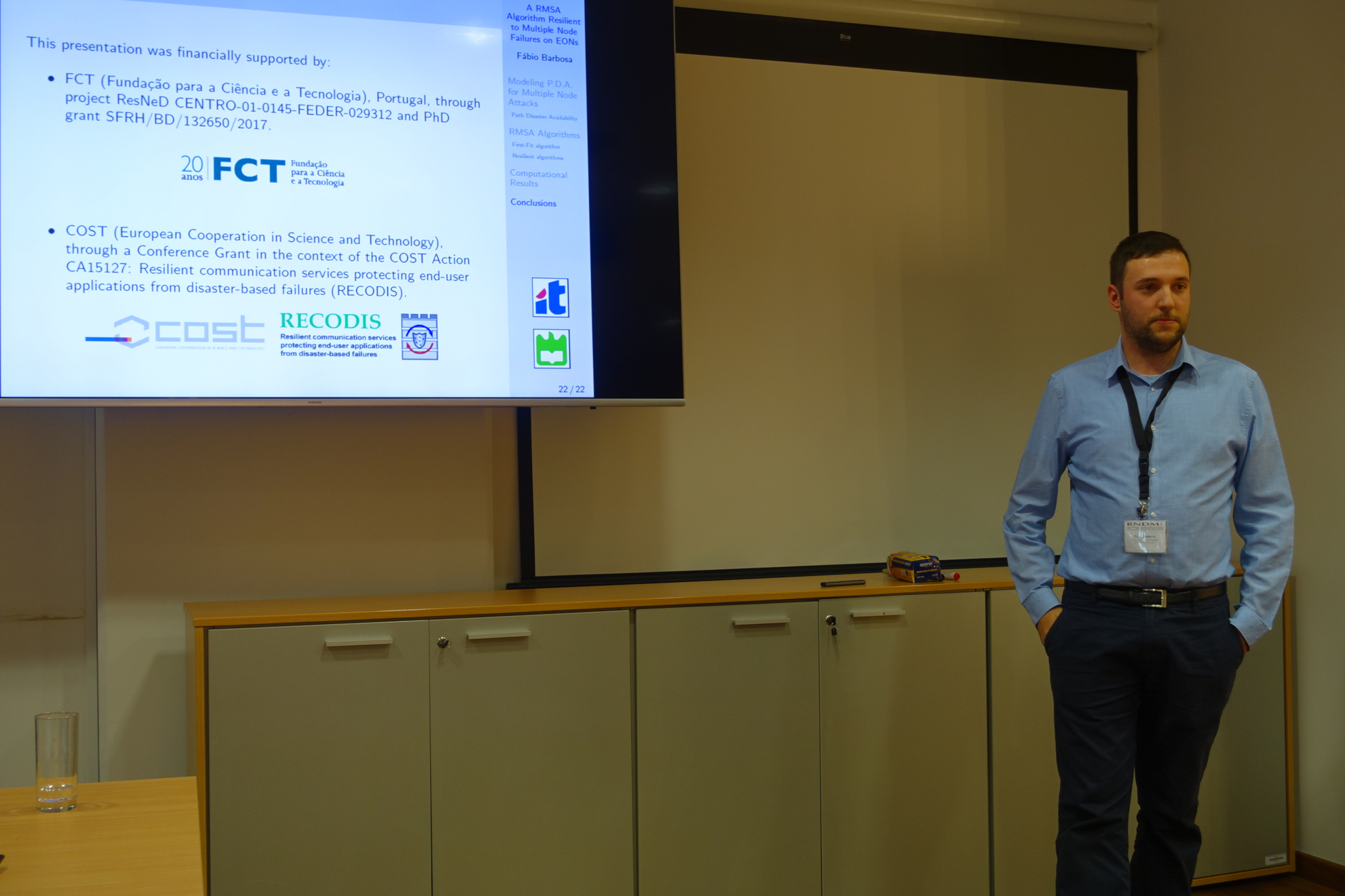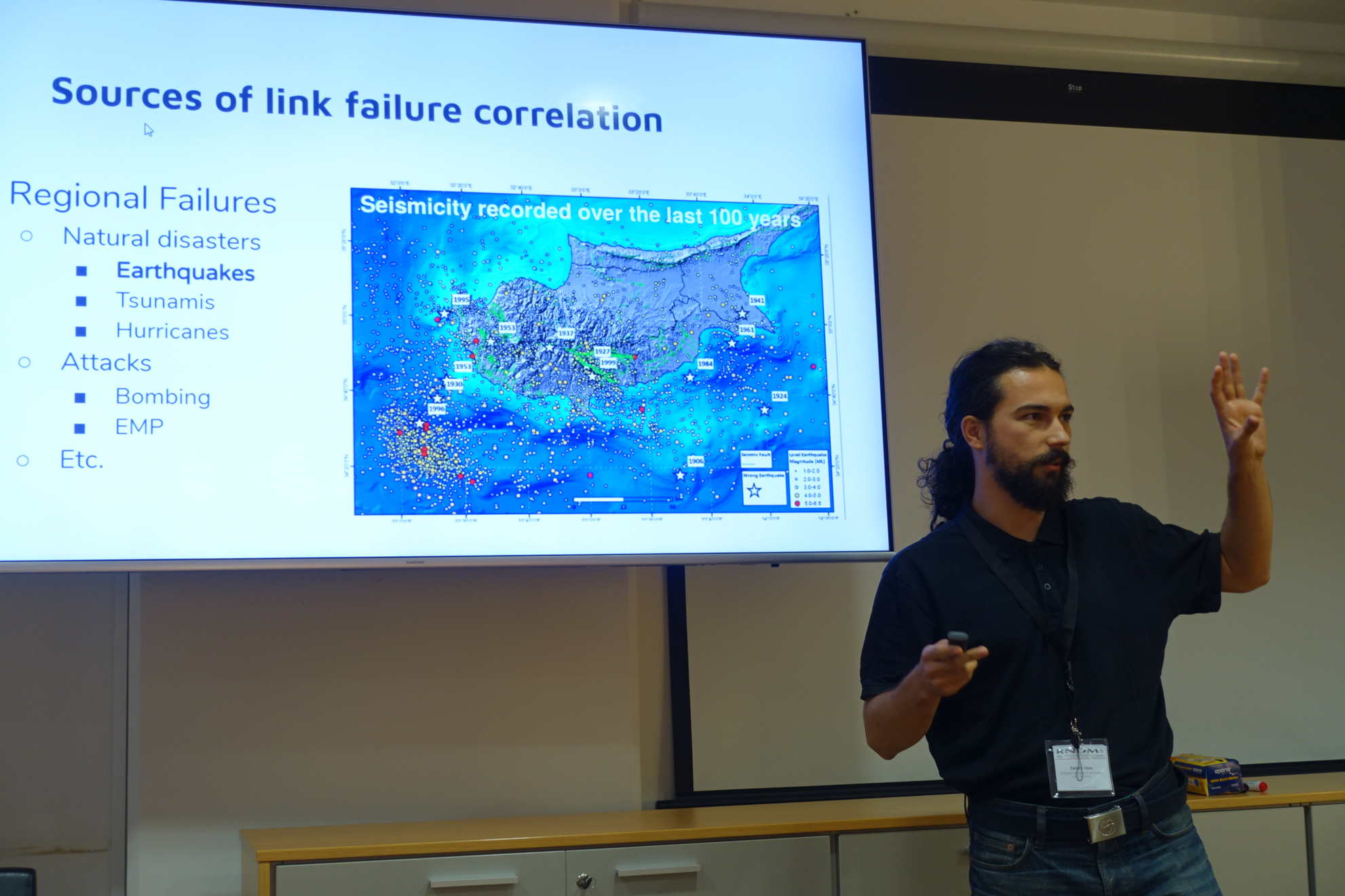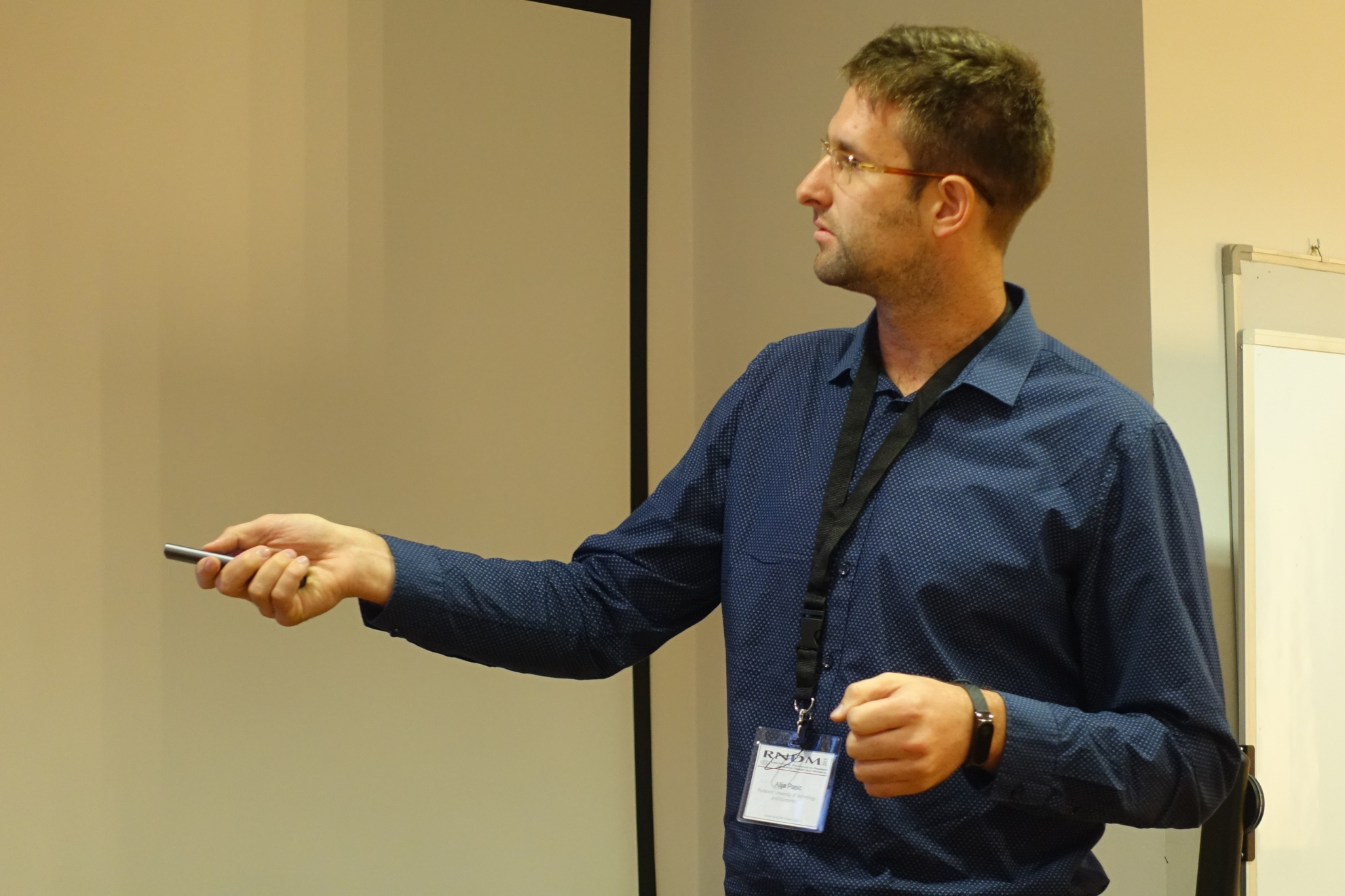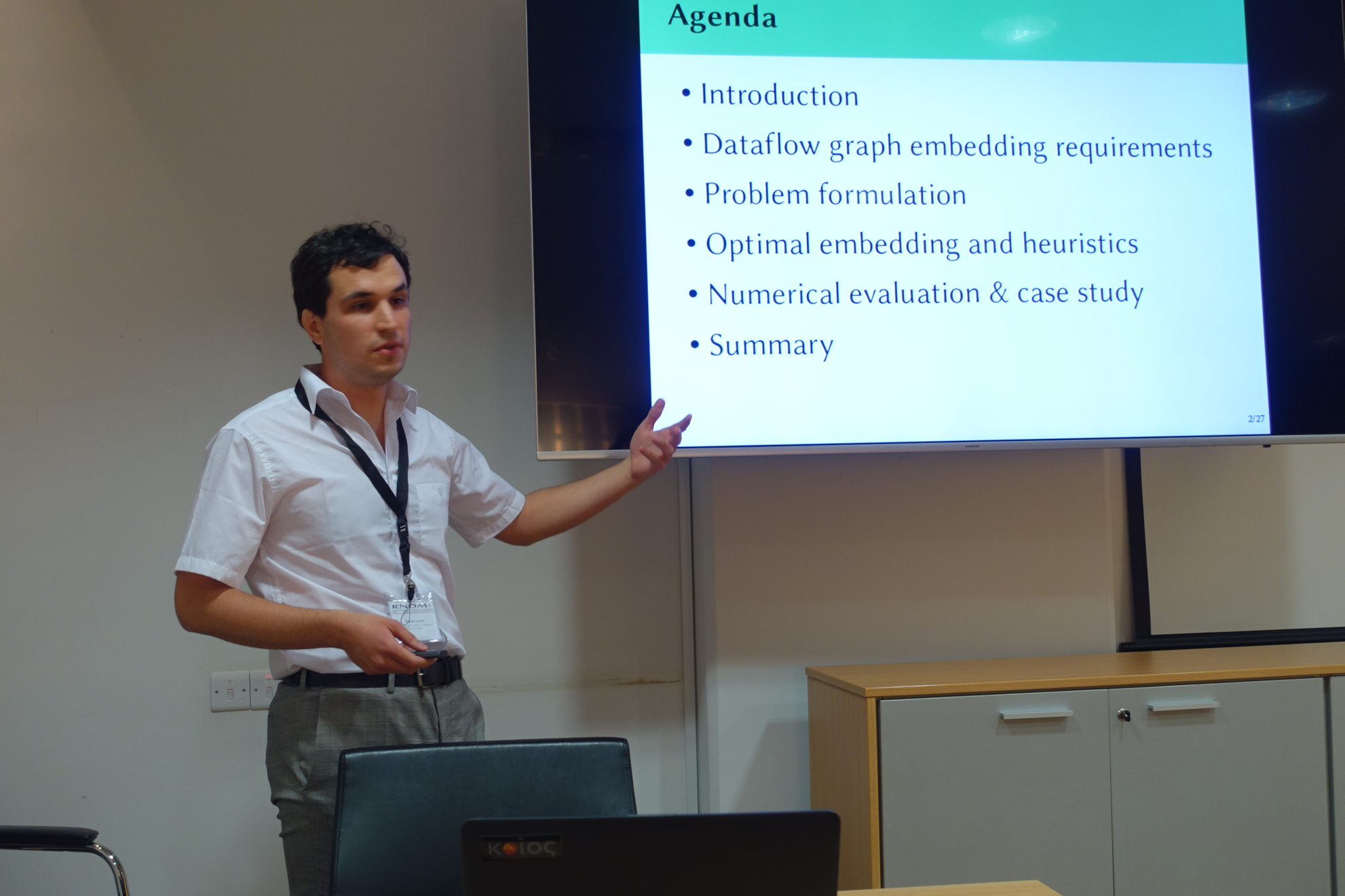| This section provides information on conference grants funded by RECODIS offered to Early Career Investigators (PhD students and young researchers up to 8 years after obtaining their PhD) from Inclusiveness Target Countries to promote the scientific results of RECODIS at conferences/workshops among the Action stakeholders. |
1. Balázs Vass, Budapest University of Technology and Economics, Budapest, Hungary
Conference: INFOCOM 2018 - IEEE International Conference on Computer Communications
Date and location: Honolulu, Hawaii, USA, April 15-19, 2018
Paper title: A Tractable Stochastic Model of Correlated Link Failures Caused by Disasters
Abstract: In order to evaluate the expected availability of a service, a network administrator should consider all possible failure scenarios under the specific service availability model stipulated in the corresponding service-level agreement. Given the increase in natural disasters and malicious attacks with geographically extensive impact, considering only independent single link failures is often insufficient. In this paper, we build a stochastic model of geographically correlated link failures caused by disasters, in order to estimate the hazards a network may be prone to, and to understand the complex correlation between possible link failures. With such a model, one can quickly extract information, such as the probability of an arbitrary set of links to fail simultaneously, the probability of two nodes to be disconnected, the probability of a path to survive a failure, etc. Furthermore, we introduce a pre-computation process, which enables us to succinctly represent the joint probability distribution of link failures. In particular, we generate, in polynomial time, a quasilinear-sized data structure, with which the joint failure probability of any set of links can be computed efficiently.
2. Rasa Bruzgiene, Kaunas University of Technology, Kaunas, Lithuania
Conference: 2nd International Conference on Broadband Communications for Next Generation Networks and Multimedia Applications (CoBCom 2018)
Date and location: Graz, Austria, July 11-13, 2018
Paper title: Next Generation Robotics Swarm Positioning and Collision Detection Under A Case of Disaster
Abstract: The positioning and control of objects in indoor environments are still an open and very challenging problem, especially in a case of disasters. Due to this, the authors presented a composite algorithm for estimation of the position and collision of the robots in a swarm in indoor environment under a case of a fire disaster. The proposed algorithm is based on a combination of Time Difference of Arrival, Radio Signal Strength Indicator fingerprint and distance evaluation using ultrasound technology. The investigations, scenarios of robots’ navigation in a testbed, results of robots’ position as well errors in position evaluation are presented in this paper.
3. Alija Pašić, Budapest University of Technology and Economics, Budapest, Hungary
Workshop: RNDM 2018 – 10th International Workshop on Resilient Networks Design and Modeling
Date and location: Longyearbyen, Norway, August 27-29, 2018
Paper title: FRADIR: A Novel Framework for Disaster Resilience
Abstract: In this paper we present a novel framework for disaster resilience, called FRADIR, which incorporates reliable network design, disaster failure modeling and protection routing in order to improve the availability of mission-critical applications. To the best of our knowledge, this is the first comprehensive framework which utilizes tools from all these fields in a joint design of disaster resilient connections. In particular, we introduce a new probabilistic regional failure model, which does not only take into account the distance from the epicenter of the failure, but includes the (improved) availability values of the network components into the model, too. Based on the failure list generated as the result of the availability-aware disaster failure model, dedicated protection approaches are used to route the connection requests. We demonstrate the concept and benefits of FRADIR through experimental results in two real-like network topologies. Our proof-of-concept implementation shows that with the interplay between protection routing, failure modeling and network update procedure the network performance in terms of blocking probability and average resource consumption can be significantly improved, which makes FRADIR a possible competitor to provide disaster resiliency in critical infrastructures.
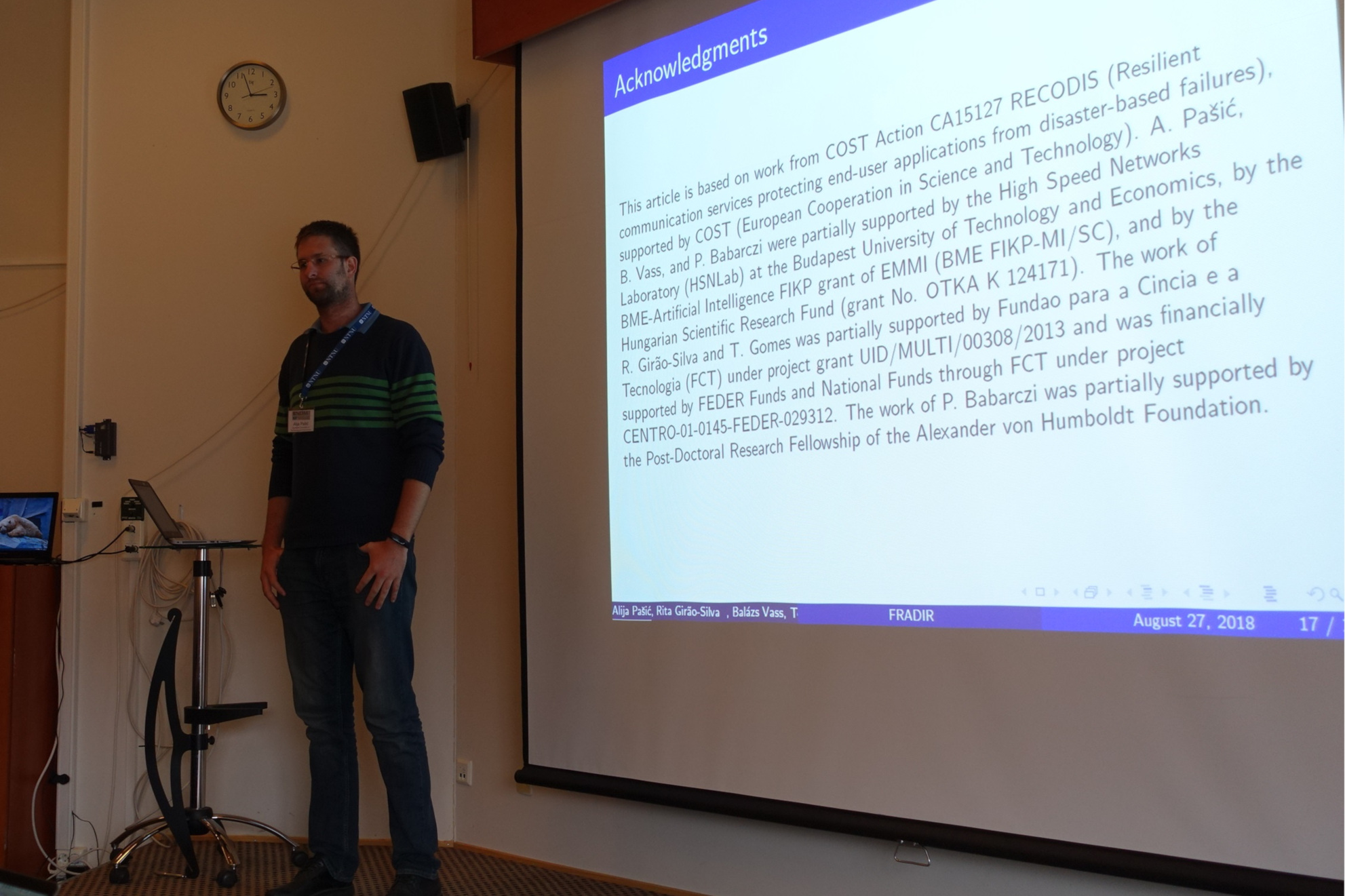
Presentation of Alija Pasic (Hungary) at RNDM 2018
4. Balázs Vass, Budapest University of Technology and Economics, Budapest, Hungary
Workshop: RNDM 2018 – 10th International Workshop on Resilient Networks Design and Modeling
Date and location: Longyearbyen, Norway, August 27-29, 2018
Paper title: Vulnerable Regions of Networks on Sphere
Abstract: Several recent works shed light on the vulnerability of networks against regional failures, which are failures of multiple equipments in a geographical region as a result of a natural disaster. In order to enhance the preparedness of a given network to natural disasters, regional failures and associated Shared Risk Link Groups (SRLGs) should be first identified. For simplicity, most of the previous works assume the network is embedded on an Euclidean plane. Nevertheless, since real networks are embedded on the Earth surface, this assumption causes distortion. In this work, we generalize some of the related results on plane to sphere. In particular, we focus on algorithms for listing SRLGs as a result of regional failures of circular shape.
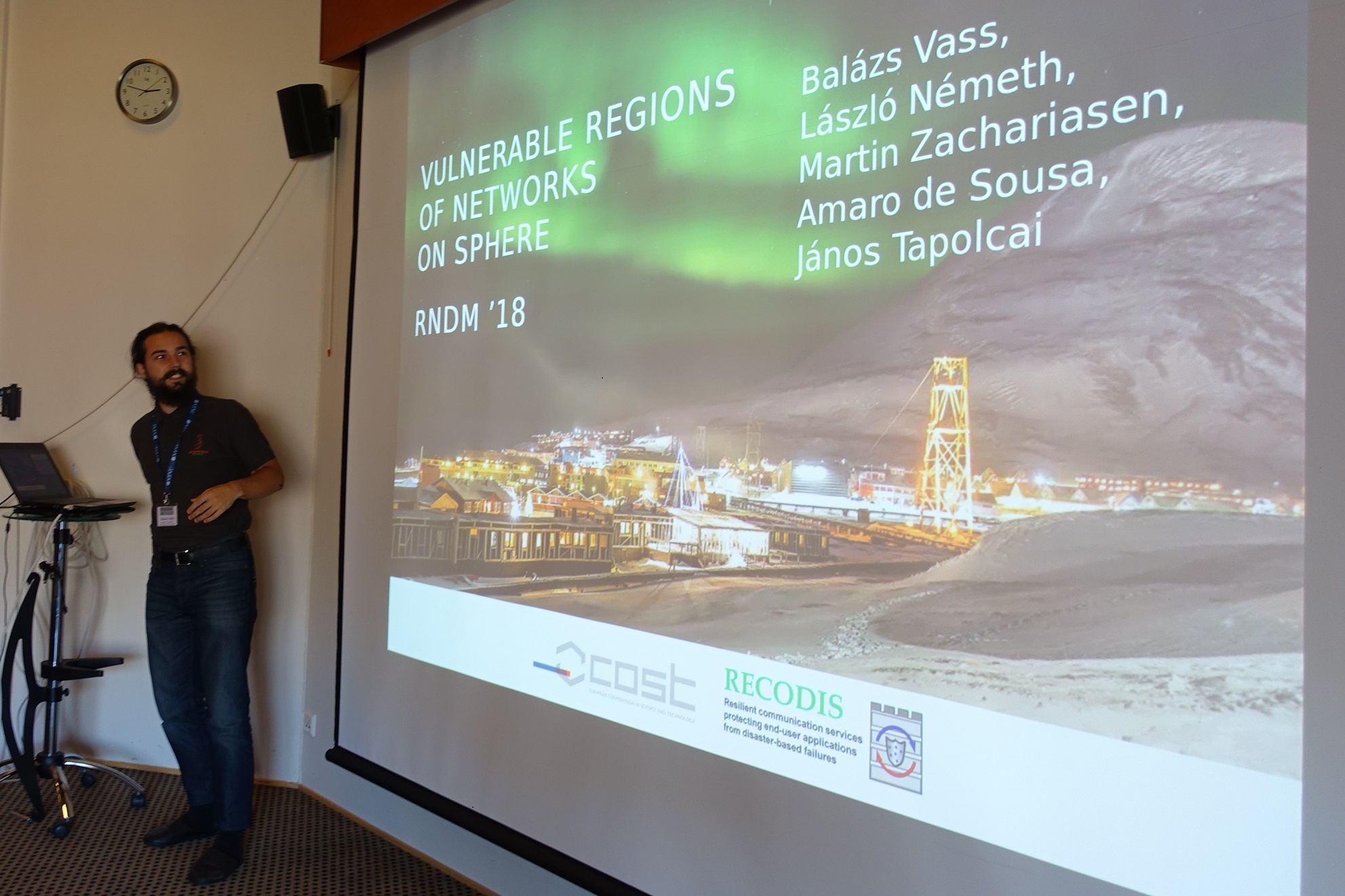
Presentation of Balazs Vass (Hungary) at RNDM 2018
5. Fabio Barbosa, Instituto de Telecomunicações, Aveiro, Portugal
Workshop: RNDM 2018 – 10th International Workshop on Resilient Networks Design and Modeling
Date and location: Longyearbyen, Norway, August 27-29, 2018
Paper title: Topology Design of Transparent Optical Networks Resilient to Multiple Node Failures
Abstract: Consider the resilience of a network defined by the average2-terminalreliability(A2TR) against a set of critical node failures. Consider an existing transparent optical network with a total fibre length L. The first goal of this paper is to assess the resiliency gap between the existing topology and a new network topology designed to maximize its resilience with the same fibre budget L. The resiliency gap gives us a measure of how good the resilience of existing network topologies are. Consider now that an existing network is upgraded with new links aiming to maximize its resiliency improvement with a fibre budget L0. The second goal of this paper is to assess how much the resiliency gap can be reduced between a good upgraded solution and a network topology designed to maximize its resiliency with the same fibre budget L+L0. The gap reduction gives us a measure of how close to the best resilience the upgraded solutions can get for different values of L0. To reach these goals, we first describe how the Critical Node Detection problem is defined and solved in the context of transparent optical networks. Then, we propose a multi-start greedy randomized method to generate network topologies, with a given fibre length budget, that are resilient to critical node failures. This method is also adapted to the upgrade of an existing network topology. At the end, we run the proposed methods on network topologies with public available information. The computational results show that the resiliency gap of existing topologies is significantly large but network upgrades with L0 = 10%L can significantly reduce the resiliency gaps provided that such upgrades are aimed at maximizing the network resilience to multiple node failures.
Presentation of Fabio Barbosa (Portugal) at RNDM 2018
6. Andrzej Kamisiński, AGH University of Science and Technology, Kraków, Poland
Workshop: RNDM 2018 – 10th International Workshop on Resilient Networks Design and Modeling
Date and location: Longyearbyen, Norway, August 27-29, 2018
Paper title: Evolution of IP Fast-Reroute Strategies
Abstract: Due to increasing requirements related to quality of service and network dependability, several IP Fast-Reroute mechanisms have been designed to limit the consequences of one or more simultaneous failures in routed computer and communication networks. However, the existing mechanisms vary in terms of the underlying concept, the maximum number of handled failures in the network, the employed signaling methods, and the operation mode. In this paper, a high-level overview of the main common features and conceptual differences of the selected IP Fast-Reroute solutions and other related mechanisms is presented and discussed, as the first step towards a more extensive and in-depth analysis. In addition, future research directions are proposed in the context of the selected challenges identified in existing networks.
Presentation of Andrzej Kamisiński (Poland) at RNDM 2018
7. Müge Sayit, Ege University, Izmir, Turkey
Conference: ICIN 2019 - Innovation in Clouds, Internet and Networks
Date and location: Paris, France, February 18-21, 2019
Paper title: Improving the QoE of DASH over SDN: A MCDM Method with an Intelligent Approach
Abstract: As being one of the most popular applications in the last decade, dynamic adaptive video streaming applications are used by Internet users every day. In such applications, the underlying architecture allows users to change quality adaptively as their request. The purpose of quality or rate adaptation algorithm is to achieve highest QoE possible. In this paper, we propose a rate adaptation algorithm which allows to increase the quality of already buffered video by using Multi-Criteria Decision Making (MCDM) method. Increasing the quality of the buffered video can be beneficial in areas from resiliency to entertainment. We propose to utilize SDN for deciding weights of MCDM method. For this purpose, SDN controller runs a machine learning algorithm by using its knowledge about current network conditions as an input of the learning algorithm. Simulation results show that users achieve higher QoE by using our approach when compared to conventional rate adaptation algorithm.

Presentation of Müge Sayit (Turkey) at ICIN 2019 (© Gael Kazaz)
8. Fabio Barbosa, Instituto de Telecomunicações, Aveiro, Portugal
Conference: DRCN 2019 - 15th International Conference on Design of Reliable Communication Networks
Date and location: Coimbra, Portugal, March 19-21, 2019
Paper title: Evaluation and Design of Elastic Optical Networks Resilient to Multiple Node Failures
Abstract: Consider an existing Elastic Optical Network (EON) with a given topology composed by nodes and connecting fibers, each fiber with a given spectrum capacity. Consider an estimated set of demands to be supported and a routing, modulation and spectrum assignment (RMSA) policy adopted by the operator both for the regular state and for the failure states. First, we address the resilience of the EON to multiple node failures by evaluating the impact of such failures in the network capacity to support the estimated demands. We adopt a worst-case approach by identifying the nodes (named critical nodes) whose simultaneous failure maximally reduce the demand percentage that is still supported by the network and we use this percentage as the resilience metric. Then, for the same estimated demands, the same RMSA policy and a fiber length budget equal to the total fiber length of the existing network, we address the design problem aiming to determine a new EON maximizing the resilience metric imposed by its critical nodes. We use a multi-start greedy randomized method that generates multiple EONs and returns the best generated one, i.e., the EON whose resilience metric is the highest. We run the proposed evaluation and design methods on known network topologies. The computational results let us (i) analyze the efficiency of the methods and (ii) assess how far the resilience of existing networks are from optimized ones

Presentation of Fabio Barbosa (Portugal) at DRCN 2019
9. Luís Garrote, University of Coimbra, Portugal
Conference: DRCN 2019 - 15th International Conference on Design of Reliable Communication Networks
Date and location: Coimbra, Portugal, March 19-21, 2019
Paper title: Weighted Euclidean Steiner Trees for Disaster-Aware Network Design
Abstract: We consider the problem of constructing a Euclidean Steiner tree in a setting where the plane has been divided into polygonal regions, each with an associated weight. Given a set of points (terminals), the task is to construct a shortest interconnection of the points, where the cost of a line segment in a region is the Euclidean distance multiplied by the weight of the region. The problem is a natural generalization of the obstacle-avoiding Euclidean Steiner tree problem, and has obvious applications in network design. We propose an efficient heuristic strategy for the problem, and evaluate its performance on both randomly generated and near-realistic problem instances. The minimum cost Euclidean Steiner tree can be seen as an optical backbone network (a Spine) avoiding disaster prone areas, here represented as higher cost regions.

Presentation of Luís Garrote (Portugal) at DRCN 2019
10. Fabio Barbosa, Instituto de Telecomunicações, Aveiro, Portugal
Workshop: RNDM 2019 – 11th International Workshop on Resilient Networks Design and Modeling
Date and location: Nicosia, Cyprus, October 14-16, 2019
Paper title: A RMSA Algorithm Resilient to Multiple Node Failures on Elastic Optical Networks
Abstract: An Elastic Optical Network (EON) provides a lot of flexibility on the way an optical network supports the demands of multiple services. This flexibility is given by the Routing, Modulation and Spectrum Assignment (RMSA) algorithm whose primary goal is to use the spectrum resources of the network in an efficient way. Recently, large-scale failures are becoming a concern and one source of such failures is malicious human activities. In terrorist attacks, although node shutdowns are harder to realize than link cuts, they are the most rewarding in the attackers’ perspective since the shutdown of one node also shuts down all its connected links. In order to obtain a RMSA algorithm resilient to multiple node failures, we propose the use of a path disaster availability metric which measures the probability of each path not being affected by a multiple node failure. We present computational results considering a mix of unicast and anycast services in 3 well-known topologies. We assess the trade-off between spectrum usage efficiency and resilience to multiple node failures of our proposal against other previous known algorithms. The results show that the RMSA decision is always better when the disaster path availability metric is used. Moreover, the best way to use the path disaster availability metric in the RMSA decision depends on the traffic load of the EON.
Presentation of Fabio Barbosa (Portugal) at RNDM 2019
11. Balázs Vass, Budapest University of Technology and Economics, Budapest, Hungary
Workshop: RNDM 2019 – 11th International Workshop on Resilient Networks Design and Modeling
Date and location: Nicosia, Cyprus, October 14-16, 2019
Paper title: Network Resiliency Against Earthquakes
Abstract: Guaranteeing a high availability of network services is a crucial part of network management. In this study, we show how to compute the availability of network services under earthquakes, by using empirical data. We take a multi-disciplinary approach and create an earthquake model based on seismological research and historical data. We then show how to integrate this empirical disaster model into existing network resiliency models to obtain the vulnerability and availability of a network under earthquakes. While previous studies have applied their models to ground shaking hazard models or earthquake scenarios, we compute (1) earthquake activity rates and (2) a relation between magnitude and disaster area, and use both as input data for our modeling. This approach is more in line with existing network resiliency models: it provides better information on the correlation between link failures than ground shaking hazard models and a more comprehensive view than a fixed set of scenarios.
Presentation of Balazs Vass (Hungary) at RNDM 2019
12. Alija Pašić, Budapest University of Technology and Economics, Budapest, Hungary
Workshop: RNDM 2019 – 11th International Workshop on Resilient Networks Design and Modeling
Date and location: Nicosia, Cyprus, October 14-16, 2019
Paper title: FRADIR-II: An Improved Framework for Disaster Resilience
Abstract: In this paper, we present a framework for disaster resilience, called FRADIR-II, which improves the performance of its previous counterpart. In the novel framework, two different failure models are jointly considered: independent random failures and regional failures that may be used to model the effect of disasters. First, we design an infrastructure against random failures, termed as the spine, which guarantees a certain availability to the working paths. Second, in order to prepare this infrastructure against disasters, we introduce a probabilistic regional failure model, where a modified Euclidean distance of an edge to the epicenter of a disaster is used. The proposed function jointly takes into account the physical length of the edges and their availability, so that a higher/lower availability is reflected in a higher/lower distance from the epicenter. This novel availability-aware disaster failure model generates a failure list which is deemed to be more realistic than previous approaches. Next, a heuristic for link upgrade attempting at the reduction of the likelihood of regional failures disconnecting the network is proposed. Finally, a generalized dedicated protection algorithm is used to route the connection requests, providing protection against the obtained failure list. The experimental results show that FRADIR-II is able to provide disaster resilience even in critical infrastructures.
Presentation of Alija Pasic (Hungary) at RNDM 2019
13. Tamás Lévai, Budapest University of Technology and Economics, Budapest, Hungary
Workshop: RNDM 2019 – 11th International Workshop on Resilient Networks Design and Modeling
Date and location: Nicosia, Cyprus, October 14-16, 2019
Paper title: Resilient Dataflow Graph Embedding for Programmable Software Switches
Abstract: Programmable software switches have become crucial building blocks in a wide range of applications, from (virtual) data center networking to telco clouds. Modern use-cases, such as 5G, require very low latency, large throughput, and high availability. Software switches generally realize the packet processing pipeline as a dataflow graph: graph nodes correspond to simple packet processing operations and graph edges represent the control flow. The efficiency and dependability of the software switch critically depends on the way the dataflow graph is mapped to the underlying hardware resources. In this paper, we focus on data flow graph embedding in a software switching context. We present an embedding approach which minimizes performance loss on inter-CPU communication across packet-processing control flow chains, and is resilient against a single CPU failure. The embedding is easy to generalize to N CPU failures. We formulate the dataflow graph embedding problem as a mathematical program, characterize the computational complexity, and we propose optimal and heuristic algorithms to solve it. The viability of our approach is confirmed in comprehensive numerical analysis on a 5G packet processing pipeline, taken from an industrial 5G NFV benchmark suite.
Presentation of Tamas Levai (Hungary) at RNDM 2019

